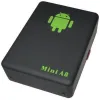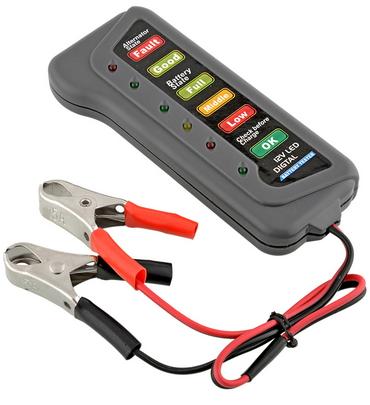
Manual of the automotive tester 12V LED BATTERY/ALTERNATOR TESTER
Руководство / инструкция

Automatic Capacity Tester Automotive Battery Automatic 12V LED BATTERY/ALTERNATOR TESTER Operating Manual
.
INTRODUCTION
Thank you for purchasing the automatic 12V LED BATTERY/ALTERNATOR TESTER storage battery. Before using this product, please read this manual carefully. Follow the instructions thoroughly and attentively to ensure your safety.
The 12V LED BATTERY/ALTERNATOR TESTER is designed for testing battery charge, checking alternator operation, and evaluating the performance of the battery.
Model Features
➠ LED process indicator
➠ Suitable for 12 V batteries
➠ No additional power supply required
WARRANTY
This product is covered by a warranty against manufacturing defects for a period of 12 months from the date of purchase. Please retain the receipt, which will be required as proof of purchase.
This warranty is void if the product is found to have been misused, shows signs of unauthorized repair, or has been used for purposes other than intended.
If a defect is discovered, the product should be returned to the place of purchase.
SAFETY INSTRUCTIONS
❗👉➨ WARNING!: High voltage is present at the following points – ignition coil, distributor cap, ignition cable, spark plugs.
❗👉➨ CAUTION: Please read this manual, as well as your vehicle’s manual, carefully before using the tester. KEEP this manual for future reference.
1. The manufacturer is not responsible for any damage or consequences resulting from:
➠ Connection and installation errors.
➠ Damage to the device due to mechanical impact, power surges, or any modifications to the device.
➠ Any unauthorized tampering with the product, which may void the warranty.
➠ Use of the device for purposes other than those described in this document.
➠ Any exposure to liquids.
2. Do not use the device in damp or wet environments.
3. Do not use the tester near flammable materials.
4. Do not use the tester in explosive environments.
5. Ensure the device is always kept in a safe place.
➠ The device must be kept out of the reach of children.
➠ Do not expose the device to direct sunlight or other sources of heat.
6. After use, store the tester in a safe and dry place.
7. Do not attempt to use other cables with the device.
8. Do not open the casing; there are no user-serviceable parts inside.
9. If the product is defective, contact your dealer.
10. Do not use the device while the vehicle is in motion; the tester is not suitable for permanent installation in the vehicle.
11. Ensure the vehicle is securely parked and the handbrake is applied. For vehicles with automatic transmission, the “park” position must be engaged, and the handbrake must be applied.
12. Do not use other measuring instruments while using the tester.
13. Seek professional assistance if you are unsure about anything related to your vehicle’s electrical system.
ADDITIONAL INFORMATION
1. The battery tester is suitable for all types of lead-acid batteries (automotive batteries).
2. The device is not intended for commercial use.
3. The device is not a measuring instrument and is not calibrated (does not have a calibration certificate).
..
EXTERNAL VIEW AND LED INDICATOR DESIGNATIONS
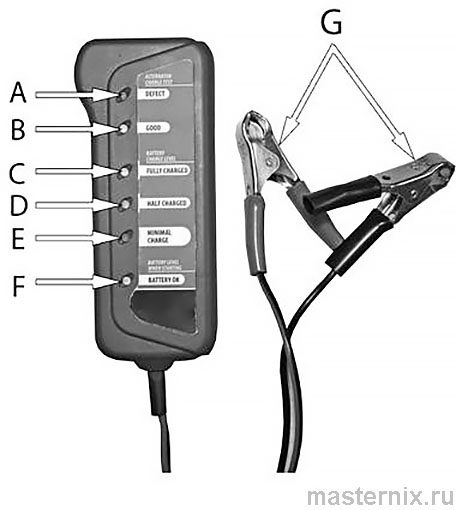
A – Alternator fault indicator
B – Alternator good condition indicator
C – Battery fully charged
G – Clamps
D – Battery half charged
E – Minimum battery charge
F – Battery good condition indicator
OPERATION OF THE 12V LED BATTERY/ALTERNATOR TESTER
BATTERY TEST
1. Connect the red clamp to the positive (+) terminal of the car battery, then connect the black clamp to the negative (–) terminal.
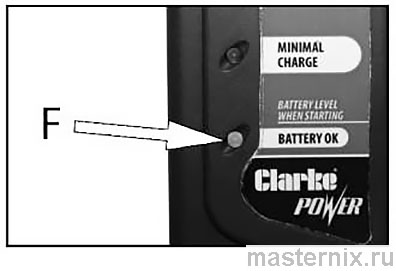
➠ The “Battery OK” LED (F) will light up if the battery voltage is at least 10 V.
2. Remove the black clamp from the negative (–) terminal of the car battery, then remove the red clamp from the positive (+) terminal.
BATTERY CONDITION DURING VEHICLE START
❗👉➨ NOTE: The battery must be fully charged.
1. Connect the red clamp to the positive (+) terminal of the car battery, then connect the black clamp to the negative (–) terminal.
2. Start the vehicle.
3. During the starting process, when the starter is operating, the message “Battery OK” is indicated. The LED (F) remains on if the voltage does not drop below 10 V.

➠ If the “Battery OK” LED (F) goes out, you should consult an automotive service workshop.
4. Remove the clamps in the reverse order.
ALTERNATOR TEST
1. Connect the red clamp to the positive (+) terminal of the battery, then connect the black clamp to the negative (–) terminal.
➠ Ensure the measuring device has a good connection to the battery.
2. Start the engine and switch on the headlights and the car radio.
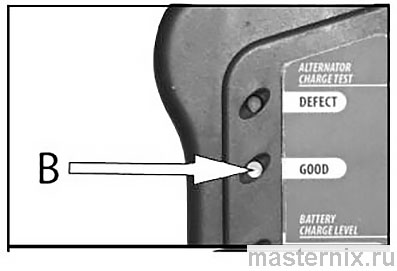
➠ The “GOOD” LED (B) lights up if the alternator is in good condition and producing the correct voltage.

➠ If the “DEFECT” LED (A) lights up, the alternator output exceeds 14.8 V, which can cause battery electrolyte evaporation. The voltage regulator is likely faulty.
➠ If no LED lights up, this means the measured voltage is less than 13.8 V. The alternator may be defective.
BATTERY CHARGE LEVEL
1. With the engine off, turn the ignition key to the first position and switch on the headlights and the rear window defroster for approximately 1–2 minutes.
2. Switch off the headlights and remove the ignition key.
3. Now disconnect the negative (–) terminal of the car battery.
4. After 10 minutes, connect the red clamp to the positive (+) terminal of the battery, then connect the black clamp to the negative (–) terminal of the battery.
5. Depending on the battery charge level, the LED will indicate:
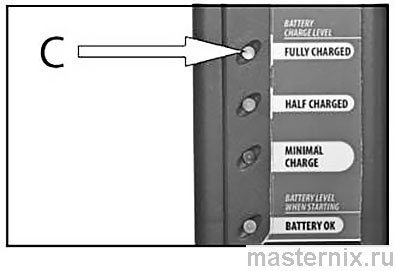
➠ FULLY CHARGED (C) – Fully charged
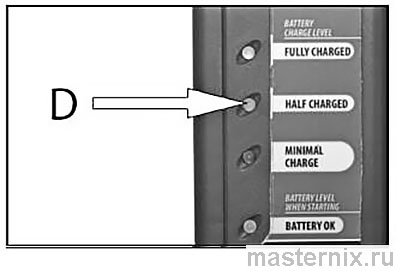
➠ HALF CHARGED (D) – Half charged
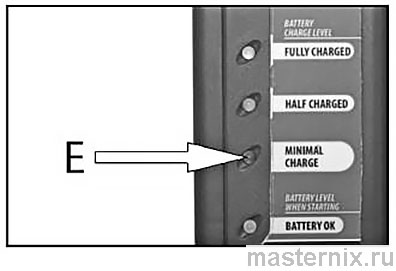
➠ MINIMAL CHARGE (E) – Minimal charge
Threshold Voltage Values for Each Measurement Interval
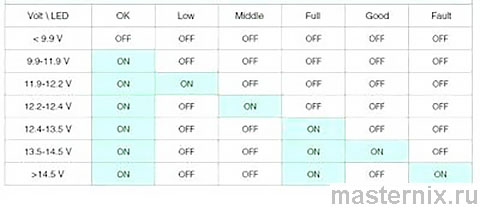
MAINTENANCE
CLEANING
➠ Do not use liquid cleaning agents.
➠ Do not use flammable cleaning agents.
➠ Do not immerse the device in water or allow liquids to spill on it.
➠ If necessary, clean the device with a light, damp, soft cloth.
SPECIFICATIONS
Product description: Alternator and battery tester
Input voltage: 12 V
Dimensions (H x L x W): 18 x 123 x 52 mm
Product weight: 0.06 kg
Fuse: No fuse
